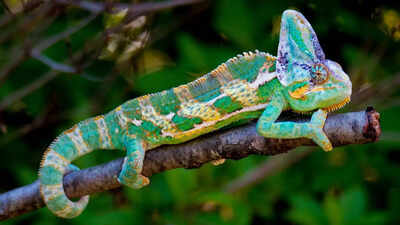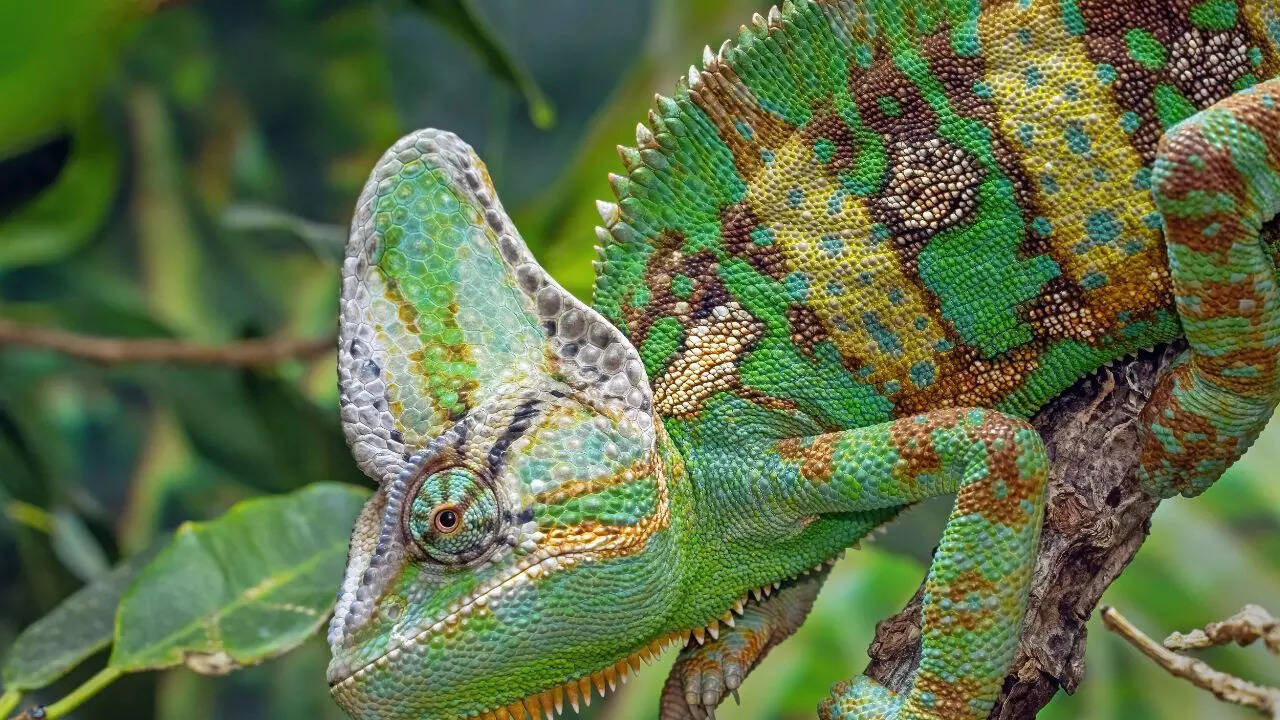ARTICLE AD BOX

Chameleons are some of the most extraordinary reptiles on Earth, famous for their dazzling colour changes, incredible eyesight, and unique adaptations. Found primarily in Africa and Madagascar, these lizards have evolved remarkable features that make them true masters of survival.
Their ability to blend into their surroundings, catch prey with lightning-fast tongues, and navigate complex arboreal habitats showcases nature’s ingenuity. Beyond their fascinating appearance, chameleons display intricate behaviours, specialised physiology, and impressive hunting strategies. Understanding these amazing creatures offers a glimpse into the wonders of evolution and the delicate balance of the ecosystems they inhabit.
10 fascinating facts about chameleon: Colour changing, hunting skills, and unique traits
1. A diverse family of over 200 speciesThere are over 200 species of chameleons, each with unique traits and adaptations. Madagascar hosts the majority of these species, creating one of the richest biodiversity hotspots on Earth. Other species inhabit forests, savannas, and deserts across Africa, Asia, and parts of Europe. Some species are tiny, measuring just a few centimetres, while others, like the Parson’s chameleon, can grow over half a metre.
Each species has evolved specific features suited to its environment, from vibrant colour patterns for communication to specialised feet and tails for navigating complex tree canopies.2. Colour change: More than just camouflageChameleons are often associated with camouflage, but their colour-changing ability serves multiple purposes. Colour shifts communicate mood, indicate aggression, attract mates, or signal submission.
Temperature and light also influence their skin tones, helping them regulate body heat. Some species display vivid patterns to intimidate rivals or deter predators, while subtle changes help them blend seamlessly with foliage.
These dynamic skin transformations are controlled by specialised cells called chromatophores, which expand or contract to alter pigments, making chameleons some of nature’s most versatile and expressive reptiles.3. Exceptional visionChameleons have some of the most advanced vision among reptiles. Each eye moves independently, allowing them to scan for predators and prey simultaneously. Their eyes can rotate almost 360 degrees, giving them unparalleled panoramic vision. Many species can perceive both visible and ultraviolet light, enhancing their ability to spot mates or detect subtle changes in the environment. This extraordinary eyesight, combined with precise depth perception, makes chameleons highly effective hunters and allows them to navigate safely through dense forests or complex terrain.

4. Prehensile feet for grippingChameleons possess unique feet adapted for life in the trees. Their toes are fused into two opposing groups, creating a pincer-like grip that secures them on branches and twigs. Combined with a prehensile tail, which acts like a fifth limb, these adaptations provide stability and balance as they climb, leap, or rest on narrow branches. Their specialised feet allow them to explore high and precarious perches, giving them access to food sources and escape routes unavailable to many other predators.5. Lightning-fast tongueChameleons catch prey using a tongue that can extend up to twice their body length in milliseconds. The tongue tip is sticky and shaped to ensnare insects, allowing them to feed efficiently from a distance. This rapid and precise mechanism enables chameleons to hunt stealthily without exposing themselves to predators. Their ability to accurately strike small, moving targets demonstrates a remarkable combination of muscular control, coordination, and sensory perception, making them one of the most efficient insect hunters in the reptile world.6. Short lifespan of some speciesWhile some chameleons live several years, certain species, like Labord’s chameleon, survive only a few months. These short lifespans are adaptations to seasonal environments, with rapid growth, early maturity, and intense reproductive cycles ensuring survival of the species. Despite their brief lives, they undergo astonishing changes in colour, size, and behaviour, demonstrating how evolution can optimise life cycles for survival in challenging habitats.7. Diet and feeding habitsMost chameleons are insectivorous, feeding on crickets, grasshoppers, and other insects. Larger species may occasionally consume small lizards, birds, or other chameleons. They hunt with patience, stalking prey before launching their lightning-fast tongues. This diet provides high protein content essential for growth, reproduction, and energy. Chameleons also adapt their hunting strategies to seasonal prey availability, showcasing their intelligence and versatility in diverse ecosystems.8. Habitat and distributionChameleons thrive in a range of habitats, from lush tropical rainforests to arid savannas and semi-deserts. Their distribution across Africa, Madagascar, and parts of Asia highlights their adaptability. Each species develops behaviours and physical traits suited to its environment, whether it’s enhanced camouflage, specialised climbing ability, or thermoregulation strategies to survive harsh temperatures.
This versatility ensures their survival across varied ecological niches.9. Reproductive strategiesChameleon reproduction varies widely. Some lay eggs, while others give birth to live young. Egg incubation can range from weeks to several months, depending on species and environmental conditions. Most chameleons do not provide parental care, leaving hatchlings to fend for themselves. Despite this, their reproductive strategies ensure that sufficient offspring survive to maintain population stability, demonstrating remarkable evolutionary efficiency.10. Conservation statusChameleons face threats from habitat destruction, climate change, and the pet trade. Some species are critically endangered, requiring urgent protection. Conservation efforts include habitat preservation, breeding programmes, and regulations on trade. Protecting chameleons helps maintain biodiversity, ecological balance, and the survival of these extraordinary reptiles for future generations.Also read | Wild hunters of rattlesnakes: Mammals, birds, and snakes that feed on venomous reptiles

 6 hours ago
5
6 hours ago
5









 English (US) ·
English (US) ·